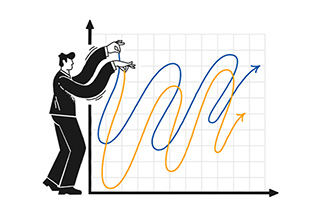There's an ETF for That!
Written by The Inspired Investor Team
Published on June 12, 2025
minute read
Share:
The ETF market is a bit like the grown-up version of a candy store. There are plenty of shapes, colours and flavours to choose from, and there’s something for almost every palate. With so many types on the shelf, investors can mix and match ETFs based on their appetite for risk, what they believe in, or strategies they want to try. Just like with candy, the fun (and the challenge) is in picking the right mix. When the first exchange-traded fund (ETF) launched in 1990 – right here at home in Canada – to track the 35 largest companies on the Toronto Stock Exchange, few would likely have imagined just how massive this market would become. As of May 2024, there were more than 12,000 ETFs listed globally, with an estimated US$13 trillion in assets.1
If you’re not familiar with this still-growing market, ETFs are similar to mutual funds in that they hold a mix of investments, like stocks or bonds, but they trade like stocks on an exchange (closed-ended mutual funds may also trade on exchanges, but open-ended mutual funds don’t) and behind the scenes, ETF issuers make sure there are enough ETF shares to meet demand and ensure fair prices. Initially, ETFs were often used as a way to easily trade a portfolio of stocks, but there are now many other kinds of funds, including fixed income ETFs; ETFs that focus on commodities such as oil, gold and wheat; ETFs that track cryptocurrencies such as Bitcoin and Ethereum, and ETFs that invest in a niche area of the market. ETFs generally offer lower management fees and higher liquidity than mutual funds.
What ETF is right for you will depend on several factors – your investment style, risk tolerance level, time horizon, financial goals and more. Before you try and find the right ETFs for your portfolio, you’ll want to find out more about the various options that are out there.
Passive ETFs
When most people talk about ETFs, they’re referring to the traditional passive funds. These securities replicate the performance of a benchmark, whether it be for equities, fixed-income or commodities. If an index rises or falls, the ETF will increase or decrease to a similar degree. These funds don’t rely on a manager to pick stocks, which is why they’re called passive investments.
All-in-One ETFs
The beauty of ETFs is that you can pick as few or as many as you’d like and still build a fully diversified portfolio. For those who don’t want to spend tons of time researching each type of fund, there are single all-in-one funds that hold stocks (and bonds, if you want an ETF with a mix) from most countries, sectors and asset classes around the world. Depending on your investment objectives and financial situation, you may find that one fund meets most of your needs.
Global ETFs
If you want to take your portfolio to new locales, there are several geographic-focused ETFs. Some cover large regions, such as a European or EAFE (that stands for Europe, Australasia and Far East) ETF, but you can also purchase funds that cover a particular market, such as U.S., Germany, China and so on.
Sector-specific ETFs
Got a good understanding of a specific sector? Then you could own an industry-centred ETF, such as a technology, energy, financial or consumer staples fund. You can even get more focused and look at a variety of subsectors, such as oil and gas explorers, biotechnology or aerospace and defence, the latter of which is a subset of the industrials sector.
Thematic ETFs
New technologies, demographic shifts and the energy transition are causing societal change. If you want to invest in the many innovations that may be coming our way, you’re in luck. Thematic ETFs, some of which focus on clean energy, autonomous vehicles, immunology and more, own companies that are pushing the planet into new directions.
Actively managed ETFs
If you want something with more oversight, the ETF market has evolved well beyond simply mirroring a benchmark. Actively managed ETFs are among the fastest-growing categories of ETFs. As of February 2025, there were about 3,400 actively managed ETFs globally, worth a record US$1.26 trillion.2 Some active strategies automatically follow a set of rules or factors, like growth, value or momentum, that determine when to increase or reduce exposure to a particular company, while others have an actual portfolio manager behind the wheel handpicking what goes into the fund. Investors should note though, that actively managed ETFs might come with higher fees than other passive ETFs as they often include a higher management expense ratio (MER).
Hedged and Unhedged ETFs
When you make an investment in securities based outside of Canada, the exchange rate could cut into or boost your returns. If the loonie strengthens relative to the currency in which your investment resides, it could diminish your return, and if the Canadian dollar falls versus its foreign counterpart, you could earn more. It can be a challenge to navigate currency-related ups and downs, which is why there are a plethora of Canadian-listed currency-hedged ETFs sold in Canadian dollars that target foreign markets. Essentially, by owning a CAD-hedged ETF, you’ll capture the performance of a particular market while mitigating how much the exchange rates could affect your return. For example, if the S&P 500 goes up 1%, the goal of the CAD-hedged ETF is to also go up 1%, regardless of currency fluctuations – and if the S&P 500 goes down 1%, the CAD-hedged ETF would also aim to go down 1%.
Leveraged ETFs
Those with a penchant for more risk have the potential to magnify gains – or losses – with leverage ETFs. These funds use borrowing or other financial tools to increase exposure to the underlying asset to potentially boost returns for the ETF holder. If the underlying asset rises by 1 percent in a day, then a two-times leveraged fund would return about 2%. There are also leveraged ETFs that will offer three-times return. These ETFs come with higher levels of risk, so they are not intended to be held for long holding periods – most often no more than a day.
Inverse ETFs
Investors don’t always have to count on markets to rise to make money. Inverse ETFs provide a simpler, yet still risky, way to short a market or even a single asset in some cases. Similar to shorting a stock, the value of an Inverse ETF will rise if the index or commodity it’s attached to falls, and vice-versa. Inverse leveraged ETFs, which are available in two times and three times versions, combine both leverage and shorting. With a two times version, if the index you’re tracking falls by 1 per cent, you could make two times the gain. Because of the risk, these ETFs are also intended for shorter holding periods, usually no more than a day.
There are other types of ETFs out there too - like cryptocurrency, dividend, commodity and currency ETFs, and more that you might want to explore.
Because there are so many funds to choose from, you must be sure you’re buying the right ones for your portfolio. Before purchasing, it can be a good idea to look at what stocks, bonds or other investments are held in the ETFs you have your eye on. Do those holdings make sense in your overall portfolio? Also, you might want to consider management fees, including MER, as they might have an impact on your return. You might also want to look into whether the company that’s selling those funds has a track record of success. Ultimately, though, if you think you have a good investing idea, there’s probably an ETF for it.
Sources
1. JP Morgan, "ETF market guide: What are the trends and themes to watch?", October 2024
2. ETFGI, "ETFGI reports that assets invested in actively managed ETFs listed globally reached a new record of US$1.26 trillion at the end of February", March 2025
RBC Direct Investing Inc. and Royal Bank of Canada are separate corporate entities which are affiliated. RBC Direct Investing Inc. is a wholly owned subsidiary of Royal Bank of Canada and is a Member of the Canadian Investment Regulatory Organization and the Canadian Investor Protection Fund. Royal Bank of Canada and certain of its issuers are related to RBC Direct Investing Inc. RBC Direct Investing Inc. does not provide investment advice or recommendations regarding the purchase or sale of any securities. Investors are responsible for their own investment decisions. RBC Direct Investing is a business name used by RBC Direct Investing Inc. ® / ™ Trademark(s) of Royal Bank of Canada. RBC and Royal Bank are registered trademarks of Royal Bank of Canada. Used under licence.
© Royal Bank of Canada 2025.
Any information, opinions or views provided in this document, including hyperlinks to the RBC Direct Investing Inc. website or the websites of its affiliates or third parties, are for your general information only, and are not intended to provide legal, investment, financial, accounting, tax or other professional advice. While information presented is believed to be factual and current, its accuracy is not guaranteed and it should not be regarded as a complete analysis of the subjects discussed. All expressions of opinion reflect the judgment of the author(s) as of the date of publication and are subject to change. No endorsement of any third parties or their advice, opinions, information, products or services is expressly given or implied by RBC Direct Investing Inc. or its affiliates. You should consult with your advisor before taking any action based upon the information contained in this document.
Furthermore, the products, services and securities referred to in this publication are only available in Canada and other jurisdictions where they may be legally offered for sale. Information available on the RBC Direct Investing website is intended for access by residents of Canada only, and should not be accessed from any jurisdiction outside Canada.
Explore More

5 Ways to Get More Out of Your RESP
How can you make the most of this investment vehicle? We explain.
minute read

ETF Trends from the RBC Capital Markets Trading Floor – May 2025
Here’s what we saw on the trading floor in May 2025
minute read

Why Order Types Matter During Market Volatility
When markets swing, how you place a trade can make a difference
minute read
Inspired Investor brings you personal stories, timely information and expert insights to empower your investment decisions. Visit About Us to find out more.







